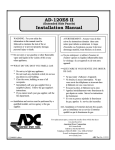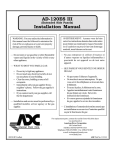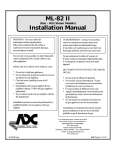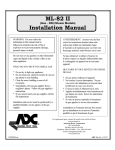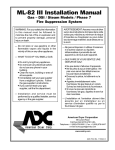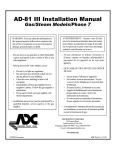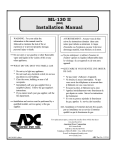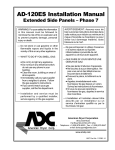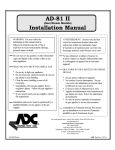Download ADC AD-120ES Operator`s manual
Transcript
AD-120ES (Gas/Electric/Steam) Exhaust Addendum WARNING: For your safety the information in this manual must be followed to minimize the risk of fire or explosion or to prevent property damage, personal injury or death. AVERTISSEMENT: Assurez-vous de bien suivre les instructions données dans cette notice pour réduire au minimum le risque d’incendie ou d’explosion ou pour éviter tout dommage matériel, toute blessure ou la mort. Do not store or use gasoline or other flammable vapor and liquids in the vicinity of this or any other appliance. Ne pas entreposer ni utiliser d’essence ni d’autres vapeurs ou liquides inflammables dans le voisinage de cet appareil ou de tout autre appareil. WHAT DO YOU DO IF YOU SMELL GAS * Do not try to light any appliance. * Do not touch any electrical switch; do not use any phone in your building. * Clear the room, building or area of all occupants. * Immediately call your gas supplier from a neighbor's phone. Follow the gas supplier's instructions. * If you cannot reach your gas supplier, call the fire department. Installation and service must be performed by a qualified installer, service agency or the gas supplier. QUE FAIRE SI VOUS SENTEZ UNE ODEUR DE GAZ: * Ne pas tenter d’allumer d’appareil. * Ne touchez à aucun interrupteur. Ne pas vous servir des téléphones se trouvant dans le bâtiment où vous vous trouvez.. * Évacuez la pièce, le bâtiment ou la zone. * Appelez immédiatement votre fournisseur de gaz depuis un voisin. Suivez les instructions du fournisseur. * Si vous ne pouvez rejoindre le fournisseur de gaz, appelez le service des incendies. L’installation et l’entretien doivent être assurés par un installateur ou un service d’entretien qualifié ou par le fournisseur de gaz. For replacement parts, contact the distributor from which the dryer was purchased or American Dryer Corporation 88 Currant Road Fall River MA 02720-4781 Telephone: (508) 678-9000 / Fax: (508) 678-9447 E-mail: [email protected] 021899DMG/cj ADC Part No. 113082 Retain This Addendum In A Safe Place For Future Reference American Dryer Corporation products embody advanced concepts in engineering, design, and safety. If this product is properly maintained, it will provide many years of safe, efficient, and trouble-free operation. ONLY qualified technicians should service this equipment. OBSERVE ALL SAFETY PRECAUTIONS displayed on the equipment or specified in the installation/operator's manual included with the dryer. The following “FOR YOUR SAFETY” caution must be posted near the dryer in a prominent location. FOR YOUR SAFETY POUR VOTRE SÉCURITÉ Do not store or use gasoline or other flammable vapors or liquids in the vicinity of this or any other appliance. Ne pas entreposer ni utiliser d’essence ni d’autres vapeurs ou liquides inflammables dans le voisinage de cet appareil ou de yout autre appareil. We have tried to make this manual as complete as possible and hope you will find it useful. ADC reserves the right to make changes from time to time, without notice or obligation, in prices, specifications, colors, and material, and to change or discontinue models. Important For your convenience, log the following information: DATE OF PURCHASE MODEL NO. AD-120ES DISTRIBUTORS NAME Serial Number(s) Replacement parts can be obtained from your distributor or the ADC factory. When ordering replacement parts from the factory, you can FAX your order to ADC at (508) 678-9447 or telephone your orders directly to the ADC Parts Department at (508) 678-9000. Please specify the dryer model number and serial number in addition to the description and part number, so that your order is processed accurately and promptly. The illustrations on the following pages may not depict your particular dryer exactly. The illustrations are a composite of the various dryer models. Be sure to check the descriptions of the parts thoroughly before ordering. “IMPORTANT NOTE TO PURCHASER” Information must be obtained from your local gas supplier on the instructions to be followed if the user smells gas. These instructions must be posted in a prominent location near the dryer. Table of Contents A. B. C. D. SPECIFICATIONS.......................................................................................................................... 2 UNPACKING AND SETTING UP .................................................................................................. 3 DRYER ENCLOSURE REQUIREMENTS .................................................................................... 4 EXHAUST REQUIREMENTS ....................................................................................................... 5 ADG-120ES ADE-120ES ADS-120ES A. SPECIFICATIONS GAS AND 72 KW ELECTRIC STEAM AND 80 KW ELECTRIC EXHAUST D UCT D IA. D IM. "A" DIM. "A" 14" 30.5 cm 11-1/4" 28.6 9-1/2" 24.1 cm 16" 40.6 cm 9" 22.9 cm 9" 22.9 cm NOTE: OPERATING HEIGHT OF STEAM DRYER is 89 inches (226.1 cm). NOTE: ADC reserves the right to make changes in specifications at any time, without notice or obligation. NOTE: Duct work size varies with installation conditions. 2 WARNING An exhaust duct transition piece is shipped inside of the dryer’s tumbler and MUST be installed on the dryer’s exhaust duct, with the hardware provided, BEFORE location venting is connected to the dryer. THIS EXHAUST DUCT TRANSITION PIECE MUST BE INSTALLED FIRST! Failure to observe this installation requirement may result in damage to the dryer, create a FIRE HAZARD and will VOID the manufacturer’s warranty. 012999JEV-GS/cj P/N: 114092 B. UNPACKING and SETTING UP 1. Inside the tumbler of this dryer there is an exhaust transition piece that must be installed on the outlet of the exhaust before any further venting is connected to do this follow this procedure: a. Remove the exhaust transition piece from the tumbler and place on the exhaust outlet. b. Using the screws provided secure the exhaust transition piece to the dryer. NOTE: It is recommended that this joint be taped as well as all other duct work joints to prevent moisture and lint from escaping into the building. 3 C. DRYER ENCLOSURE REQUIREMENTS It is recommended that the rear of the dryer be positioned approximately three (3) feet (36-inches) from the nearest obstruction (i.e., wall) for ease of installation, maintenance, and service. Bulkheads and partitions should be made from noncombustible materials. The clearance between the bulkhead header and the dryer must be a minimum of 4 inches and must not extend more than 4 inches to the rear of the dryer front. The bulkhead facing must not be closed in all the way to the top of the dryer. A 2-inch clearance is required. NOTE: Bulkhead facing should not be installed until after dryer is in place. Ceiling area must be located a minimum of 12 inches above the top of the dryer. IMPORTANT: Even though a minimum of only 12 inches is required, 18 inches or more is suggested, for steam dryers and especially in cases where sprinkler heads are over the dryers. NOTE: When fire sprinkler systems are located above the dryers, a minimum of 18 inches above the dryer console (module) is suggested. Dryers may be positioned side wall to side wall however, 1 or 2-inches is suggested between dryers (or wall) for ease of installation and maintenance. Allowances must be made for the opening and closing of the control and lint doors. 4 D. EXHAUST REQUIREMENTS 1. GENERAL EXHAUST DUCT WORK INFORMATION Exhaust duct work should be designed and installed by a qualified professional. Improperly sized duct work will create excessive back pressure which results in slow drying, increased use of energy, overheating of the dryer, and shutdown of the burner by the airflow (sail) switches, burner hi-limits, or basket (tumbler) hi-heat thermostats. CAUTION: DRYER MUST BE EXHAUSTED TO THE OUTDOORS. CAUTION: IMPROPERLY SIZED OR INSTALLED EXHAUST DUCT WORK CAN CREATE A POTENTIAL FIRE HAZARD. NOTE: When a dryer is exhausted separately, it is recommended that a back draft damper be installed. NOTE: When dryers are exhausted into a multiple (common) exhaust line, each dryer must be supplied with a back draft damper. The exhaust duct work should be laid out in such a way that the duct work travels as directly as possible to the outdoors with as few turns as possible. Single or independent dryer venting is recommended. When single dryer venting is used, the duct work from the dryer to the outside exhaust outlet should not exceed twenty(20) feet. In the case of multiple (common) dryer venting, the distance from the last dryer to the outside exhaust outlet should not exceed twenty(20) feet. The shape of the duct work is not critical so long as the minimum cross section area is provided. It is suggested that the use of 90º turns in ducting be avoided; use 30º and/or 45º angles instead. The radius of the elbows should preferably be 1-1/2 times the diameter of the duct. Including basket/dryer elbow connections or elbows used for outside protection from the weather, no more than one (1) elbow should be used for a horizontal exhaust duct run and no more than three (3) for a vertical exhaust duct run. If more elbows are used, the cross section area of the duct work must be increased in proportion to number of elbows added. ALL duct work should be smooth inside with no projections from sheet metal screws or other obstructions which will collect lint. When adding ducts, the ducts to be added should overlap the duct to which it is connected. ALL duct work joints must be taped to prevent moisture and lint from escaping into the building. Additionally, inspection doors should be installed at strategic points in the exhaust duct work for periodic inspection and cleanout of lint from the duct work. IMPORTANT: Exhaust back pressure measured by a manometer at the dryer exhaust duct area must not exceed 0.3 inches of water column. 5 NOTE: Where the exhaust duct work passes through a wall, ceiling, or roof made of combustible materials, the opening must be 2-inches larger (all the way around) than the duct. The duct must be centered within this opening. a.Outside Duct Work Protection 1) To protect the outside end of horizontal duck work from the weather, a 90° elbow bent downward should be installed where the exhaust exits the building. If the exhaust duct work travels vertically up through the roof, it should be protected from the weather by using a 180° turn to point the opening downward. In either case, allow at least twice the diameter of the duct between the duct opening and the nearest obstruction. IMPORTANT: DO NOT use screens or caps on the outside of opening of exhaust duct work. 6 2. SINGLE DRYER VENTING Where possible, it is suggested to provide a separate exhaust duct for each dryer. The exhaust duct should be laid out in such a way that the duct work travels as directly as possible to the outdoors with as few turns as possible. It is suggested that the use of 90° turns in ducting be avoided; use 30° and/or 45° angles instead. The shape of the exhaust duct work is not critical so long as the minimum cross section area is provided. IMPORTANT: Minimum duct size for a gas dryer or 72 Kw electric dryer is 14 inches for a round duct or 12.50" for a square duct. The minimum duct size for a steam dryer or 80 Kw electric dryer is 16 inches for a round duct or 14.50" x 14.50" for a square duct. Duct size must not be reduced anywhere down stream of dryer. IMPORTANT: Exhaust back pressure measured by a manometer at each basket (tumbler) exhaust duct area should not exceed 0.3 inches of water column. It is suggested that the duct work from each dryer (minimum 14 inches for a gas dryer or 72 Kw electric dryer and 16 inches for a steam dryer or 80 Kw electric dryer) not exceed twenty (20) feet with no more than one (1) elbow should be used for a horizontal exhaust duct run and no more than three (3) for a horiztonal duct run (including dryer connections and outside exhaust outlets). If the duct work exceeds twenty (20) feet or has numerous elbows, the cross section area of the duct work must be increased in proportion to the length and number of elbows in it. In calculating duct size, the cross section area of a square or rectangular duct must be increased by twenty (20) percent for each additional twenty (20) feet. The diameter of a round exhaust duct should be increased ten (10) percent for each additional fifteen (15) feet. Each 90° elbow is equivalent to an additional thirty (30) feet, and each 45° elbow is equivalent to an additional fifteen (15) feet. 7 IMPORTANT: For extended duct work runs, the cross section area of the duct can only be increased to an extent. When the duct work approaches the maximum limits as noted in this manual, a professional heating venting air conditioning (HVAC) firm should be consulted for proper venting information. ALL duct work should be smooth inside with no projections from sheet metal screws or other obstructions which will collect lint. When adding ducts, the duct to be added should overlap the duct to which it is to be connected. ALL duct work joints must be taped to prevent moisture and lint from escaping into the building. Inspection doors should be installed at strategic points in the exhaust duct work for periodic inspection and clean-out of lint from the duct work. NOTE: Where the exhaust duct passes through a wall, ceiling, or roof made of combustible materials, the opening must be 2-inches larger (all the way around) than the duct. The duct must be centered within this opening. a. Outside Duct Work Protection 1) To protect the outside end of horizontal duct work from the weather, a 90° elbow bent downward should be installed where the exhaust exits the building. If the exhaust duct work travels vertically up through the roof, it should be protected from the weather by using a 180° turn to point the opening downward. In either case, allow at least twice the diameter of the duct between the duct opening and nearest obstruction. IMPORTANT: DO NOT use screens, louvers, or caps on the outside of opening of exhaust duct work. 3. MULTIPLE DRYER (COMMON) VENTING If it is not feasible to provide separate exhaust ducts for each dryer, ducts from individual dryers may be channeled into a "common main duct". The individual ducts should enter the bottom or side of the main duct at an angle not more than 45° in the direction of air flow and should be spaced at least 48-3/8 inches apart. The main duct should be tapered, with the diameter increasing before each individual 14-inch (minimum for gas dryers or 72 Kw electric dryers) or 16-inch (minimum for steam dryers or 80 Kw electric dryers) duct is added. IMPORTANT: The AD-120ES is not provided with a back draft damper. When exhausted into a multiple (common) exhaust line, a back draft damper must be installed at each dryer duct. IMPORTANT: No more than four (4) dryers should be connected to one main common duct. 8 The main duct may be any shape or cross sectional area, so long as the minimum cross section area is provided. The illustrations on pages 10 and 11 show the minimum cross section area for multiple dryer round or square venting. These figures must be increased 10 square inches when rectangular main ducting is used, and the ratio of duct width to depth should not be greater than 3-1/2 to 1. These figures must be increased in proportion if the main duct run to the last dryer to where it exhausts to the outdoors is unusually long (over twenty [20] feet) or has numerous elbows (more than one [1] elbow) in it. In calculating duct work size, the cross section area of a square or rectangular duct must be increased twenty (20) percent for each additional twenty (20) feet. The diameter of a round exhaust must be increased ten (10) percent for each additional twenty (20) feet. Each 90° elbow is equivalent to an additional thirty (30) feet, and each 45º elbow is equivalent to an additional fifteen (15) feet.. IMPORTANT: For extended duct work runs, the cross section area of the duct work can only be increased to an extent. When the duct work approaches the maximum limits as noted in this manual, a professional HVAC firm should be consulted for proper venting information. IMPORTANT: Exhaust back pressure measured by a manometer at each dryer exhaust duct area should not exceed 0.3 inches of water column. The duct should be smooth inside with no projections from sheet metal screws or other obstructions which will collect lint. When adding ducts, the duct to be added should overlap the duct to which it is to be connected. ALL duct work joints must be taped to prevent moisture and lint from escaping into the building. Inspection doors should be installed at strategic points in the exhaust duct work for periodic inspection and clean-out of lint from the duct work. NOTE: Where the exhaust passes through a wall, ceiling, or roof made of combustible materials, the opening must be 2 inches larger (all the way around) than the duct. The duct must be centered within this opening. a. Outside Duck Work Protection 1) To protect the outside end of horizontal duct work from the weather, a 90° elbow bent downward should be installed where the exhaust exits the building. If the exhaust duct work travels vertically up through the roof, it should be protected from the weather by using a 180° turn to point the opening downward. In either case, allow at least twice the diameter of the duct between the duct opening and nearest obstruction. IMPORTANT: DO NOT use screens, louvers, or caps on the outside of opening of exhaust duct work. 9 MULTIPLE DRYER VENTING (ADG-120 AND ADE-120) WITH 72 KW ELECTRIC OVEN) WITH 14" DIAMETER (2,150 CFM) EXHAUST CONNECTIONS AT COMMON DUCT MULTIPLE DRYER VENTING (ADE-120 WITH 80 KW ELECTRIC OVEN) WITH 16" DIAMETER (2,500 CFM) EXHAUST CONNECTIONS AT COMMON DUCT 10 MULTIPLE DRYER VENTING (ADS-120) WITH 16" DIAMETER (2,750 CFM) EXHAUST CONNECTIONS AT COMMON DUCT 11 ADC 113082 1- 02/24/99-100 4- 05/09/00-150 2- 03/30/99-250 5- 10/02/00-150 3* 04/25/00-17














